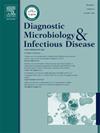A Balamuthia amoebic encephalitis survivor in China, and literature review
IF 2.1
4区 医学
Q3 INFECTIOUS DISEASES
Diagnostic microbiology and infectious disease
Pub Date : 2025-01-17
DOI:10.1016/j.diagmicrobio.2025.116698
引用次数: 0
Abstract
Balamuthia amoebic encephalitis (BAE) is a rare, fatal parasitic infection of the central nervous system, with a current mortality rate above 95%. The high fatality rate is largely attributed to atypical clinicopathological features, delayed diagnosis, and the absence of effective treatment methods, so quick recognition of this disease is vital. In this paper, we present a survivor of BAE, who was confirmed through histologic examination and metagenomic next-generation sequencing (mNGS) of brain lesions. This case, unlike most previous reports, was a successful survival case. It highlights the critical need for differential diagnosis in patients with central nervous system infectious diseases, particularly those with a history of skin lesions and patients presenting multifocal brain lesions. Moreover, mNGS could serve as a useful tool in rapid identification of causative rare pathogens. The application of decompressive craniectomy may offer treatment opportunities and improve the survival rate of BAE. The case description was followed by a review of the literatures, in order to improve clinicians' understanding of this disease.
求助全文
约1分钟内获得全文
求助全文
来源期刊
CiteScore
5.30
自引率
3.40%
发文量
149
审稿时长
56 days
期刊介绍:
Diagnostic Microbiology and Infectious Disease keeps you informed of the latest developments in clinical microbiology and the diagnosis and treatment of infectious diseases. Packed with rigorously peer-reviewed articles and studies in bacteriology, immunology, immunoserology, infectious diseases, mycology, parasitology, and virology, the journal examines new procedures, unusual cases, controversial issues, and important new literature. Diagnostic Microbiology and Infectious Disease distinguished independent editorial board, consisting of experts from many medical specialties, ensures you extensive and authoritative coverage.

 求助内容:
求助内容: 应助结果提醒方式:
应助结果提醒方式:


